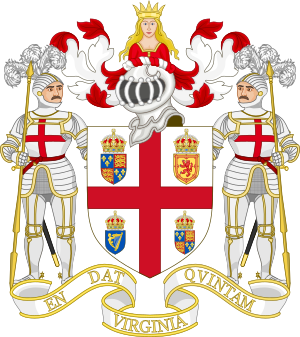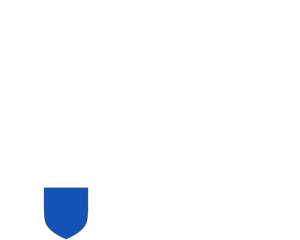Virginia Company facts for kids

|
|

Company flag (c. 1620)
|
|
|
Trade name
|
Virginia Company |
|---|---|
| Public | |
| Industry | Maritime transport, trade |
| Fate | Dissolved following transformation of Virginia into a royal colony |
| Founded | 10 April 1606 at Westminster, England |
| Founder | James I |
| Defunct | 24 May 1624 |
| Headquarters |
,
England
|
|
Area served
|
Virginia and Summer Islands |
| Products | Cash crops, timber, tobacco |
| Divisions | |
The Virginia Company was an English trading company. It was started by King James I on April 10, 1606. Its main goal was to set up English colonies on the eastern coast of America. This area was named Virginia, after Elizabeth I. It stretched from what is now Maine down to the Carolinas.
The company had two main parts. The London Company was made up of people from London. The Plymouth Company included people from Plymouth, England.
A big success for the company came when John Rolfe introduced new types of tobacco. These were sweeter than the tobacco native to Virginia. This new tobacco became a very important crop to sell. It helped the London Company and other English colonies make money.
However, the company faced big problems. In 1622, there was a large attack by Native Americans. This event is known as the Great Massacre of 1622. Many English settlers died. Because of this, King James I closed the company on May 24, 1624. Virginia then became a royal colony, directly controlled by the King. The male colonists who owned land still kept some power through the House of Burgesses.
Contents
Starting the Virginia Company
A Royal Plan for Colonies
In 1606, King James I wanted to create English settlements in America. He gave a special paper, called a charter, to a group of people. This charter allowed them to form the Virginia Company. The company's goal was to explore and settle the land.
The King set up a council in London to guide the company. This council was made up of important investors. They chose the members, and the King approved them. This council in England then told the settlers in America to create their own local council. But this local council did not work very well.
Two Companies, One Goal
The first charter in 1606 did not officially name the "Virginia Company" or "Plymouth Company." These names came later. The charter of 1609 made it clear there were two separate groups:
- The First Colony: This group included knights, gentlemen, and merchants from London. They became known as the London Company.
- The Second Colony: This group included knights, gentlemen, and others from cities like Bristol, Exeter, and Plymouth. They became known as the Plymouth Company.
Where They Could Settle
The London Company was allowed to set up a colony between 34° and 41° North latitude. This was roughly between Cape Fear and Long Island Sound. They also owned a large part of inland Canada. On May 14, 1607, the London Company founded the Jamestown Settlement. This was in what is now Jamestown, Virginia. It was about 40 miles inland along the James River.
The Plymouth Company could settle between 38° and 45° North latitude. This was roughly between the upper Chesapeake Bay and the U.S.-Canada border. On August 13, 1607, the Plymouth Company started the Popham Colony in Maine. However, this settlement was left after about a year. The Plymouth Company then became inactive for a while. Later, a new company started a permanent settlement in 1620. This was when the Pilgrims arrived in Plymouth, Massachusetts, on the ship Mayflower.
Challenges and Changes
New Rules and a Governor
The local councils in Virginia were not working well. So, the Second Charter in 1609 made some big changes. It expanded the company's land from "sea to sea." It also appointed a governor to lead the colony. Thomas West, 3rd Baron De La Warr (known as Lord Delaware) became the governor. He sailed to America in 1610. King James gave the governor of Virginia a lot of power.
The Sea Venture Shipwreck
In 1609, a large supply mission was planned. It was called the "Third Supply." A new ship, the Sea Venture, was quickly made ready. It became the main ship for a fleet of nine ships. Most of the leaders, food, and supplies were on board the Sea Venture. Important people like Admiral George Somers and Governor Sir Thomas Gates were on this ship. John Rolfe and his pregnant wife were also aboard.
The fleet ran into a terrible hurricane. The storm lasted three days and scattered the ships. The Sea Venture began to leak badly. Admiral Somers purposely ran the ship aground on a reef to stop it from sinking. This saved 150 men and women, but the ship was destroyed. The uninhabited islands where they landed were later named "The Somers Isles" after Admiral Somers. The survivors built two smaller ships from parts of the Sea Venture. They named them Deliverance and Patience.
Arrival in Jamestown
Ten months later, the survivors continued their journey to Jamestown. They arrived on May 23, 1610. They left some men behind on the islands to claim them. When they reached Jamestown, they found that over 85% of the 500 colonists had died. This terrible time was known as the "Starving Time." The Sea Venture passengers had expected to find a thriving colony. So, they had brought very little food or supplies with them.
The colonists at Jamestown were saved just three weeks later. A supply mission led by Lord Delaware arrived just in time.
Money Troubles and New Ideas
The Virginia Company of London did not find gold or silver in Virginia. This was a big disappointment for its investors. However, they did start trading other goods. The company tried to raise money through lotteries in England. But these lotteries were later stopped by the King. The company even thought about offering noble titles to get more support for the colony.
In 1612, the company's charter was officially changed. It now included the Somers Isles (Bermuda) as part of the Virginia Colony. However, these islands later went to a new company in 1615. This new company was called the London Company of the Somers Isles. It was formed by the same people who owned the London Company.
Self-Governance and Conflict
The Great Charter
On November 18, 1618, Virginia Company leaders sent important instructions to Governor George Yeardley. These instructions are often called "The Great Charter." This charter was not issued by the King himself. But it gave the colony the power to govern itself.
This led to the creation of a Council of State. The governor appointed its members. It also created an elected General Assembly, known as the House of Burgesses. This charter also changed how the colony was funded. It would no longer rely on shares from investors. Instead, it would be financed by growing and selling tobacco. The idea of representative government in the United States started with this Great Charter.
The Great Massacre and Company's End
Native American groups had become increasingly unhappy. They were upset about the colonists taking their land and treating them badly. In 1622, they launched a large attack. This event is known as the Jamestown Massacre of 1622, or the Great Massacre. It greatly reduced the number of English settlers. Survivors from about eighty plantations gathered in eight safer spots near Jamestown.
This massacre brought a lot of negative attention to the colony. King James, who had first started the company, was especially concerned. There was a big debate in Britain. Some company officers wanted to protect the original charter. Others wanted the company to be closed down.
Finally, on May 24, 1624, King James dissolved the company. Virginia then became a royal colony. This meant it was directly controlled by the King of England.
Arms
 |
|
Images for kids
See also
- List of trading companies



